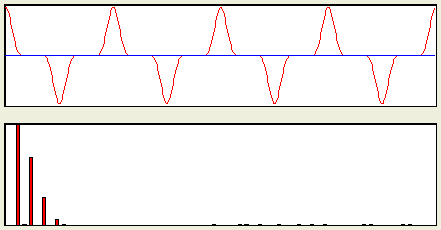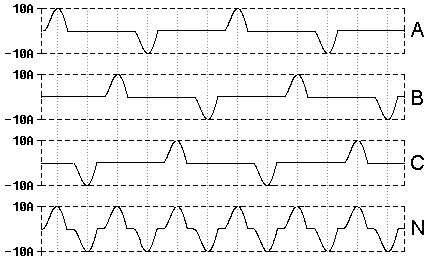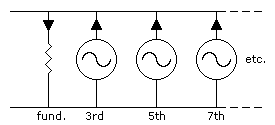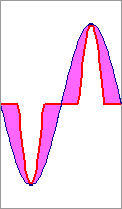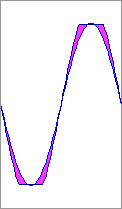|
On the previous page we introduced the subject of harmonics. But before we begin... While discussing a few aspects of harmonics with a revered university professor, he made a statement that effectively sums up this area of power quality being the understanding of harmonics is based on 'models' - and I read that to mean "not based on real life"! Models allow the subject to be broken up into understandable and easily grasped bite-size chunks - no problem with this approach at all - as long as it is remembered a complete meal is made up of all the chunks put together. Publications on harmonics have the tendency to make a complete meal out of only one bite-size chunk. A usually forgotten fact is the 'models' used to explain certain aspects are a collection of various influences; This omission leading to the result from the model being taken as the de-facto influence, and not a collection of influences. The wonderful part about the Internet is one can usually validate something read if it is read again from another unrelated source. With the subject of harmonics, though, this cannot be said as most of the material is plagiarized i.e. you're reading the same stuff over and over again (sometimes modified through someone's mis-led understanding). This is, therefore, not going to be a comprehensive discussion on the subject but rather a concentration on the teachings that prevail within this area of power quality that have a tendency to mislead (and hopefully I will also reveal the chunks left on the plate!).
A chap called Fourier introduced an idea that all repetitive waveforms can be made up from a combination of fundamental and harmonic sinewaves of varying amplitudes and phases. This principle is applied in nearly all (if not all) power quality instruments i.e. the waveform is graphically represented as a mixture of sinewaves of the fundamental and direct multiples of the fundamental frequency.
In the above example, adding some 3rd, 5th, and 7th, produces a waveform not unlike that of a single-phase hi-tech load (as shown in the previous section on "Load Linearity"). In this example of our single-phase load, the Live and Neutral are carrying the same current - just opposing in phase - thus having equal harmonic content (else the waveform would not be distorted!). If we were to then introduce such a load to each phase of a 3-phase system (see below), notice what occurs on the Neutral conductor! The waveform is no longer returning two conduction periods per cycle, but six! (two from each phase). Also, the timing is such that the predominant frequency on the Neutral conductor is not 50Hz, but 150Hz i.e. the 3rd harmonic! And so is born the whole new subject.
There is also a new factor to the current waveform appearing on the Neutral; It shows the Neutral acting as the return to all three Phases, but at different times! While any one Phase is conducting, there is no other Phase offering a cancelling current. The Neutral currents of all three phases, therefore, combine on this common Neutral thus carrying the sum of the Phase currents i.e. 3 x Phase RMS current in a equally distributed load.
He who says "non-linear loads generate harmonics" This is distinctly where the divide between power and electronic engineering shows. See if you spot the subtle but all important difference. Picture the scenario; All was well in the building. The concern on the fifth floor became so successful they needed to move to larger premises. The floor became vacant and a technology based concern took up residence. Suddenly, with all their computers and fancy peripherals, there is a power quality (specifically harmonic) issue. With the many examples of harmonic issues being associated with hi-tech load, it comes as no surprise the power engineering fraternity generally view hi-tech loads as harmonic generators i.e. the hi-tech load being seen as one which does not use up all of its fundamental current intake but converts a portion of it into multiples of the fundamental and feeds this back into the supply.
Although the diagram is full of basic errors, it is extremely difficult to stop its perpetual use in lectures on harmonics. The flawed thought process that accompanies it is just as tough to halt in light of the countless reports of electricity meters of neighbours to hi-tech users spinning at the wrong speed since the hi-tech user moved in. To the electronics chap, the primary focus is on waveform purity and recognizes the distorted current waveform of a hi-tech load can 'modulate' an imperfect source thus giving rise to the presence of extraneous frequencies (harmonics) on the source. He also understands the impure waveforms have high frequency components and therefore only uses harmonic analysis as a means to judge the impact of these components on an installation. The difference is rather blatant and clearly shows how Fourier's idea has led some power engineers to tackle problems which don't exist while not paying attention to real and important ones. Classic case in point; In the above section we showed the Neutral current to reach the sum of the phase currents, yet there is literature in circulation claiming the maximum that will be experienced is Ö3 (i.e. 1.73) times phase current. In contrast to this, there is other literature claiming when the harmonic current is excessive, the Neutral current can be well in excess of 4 times Phase current. Neither is correct! It has been clearly shown the maximum current that can be found on the Neutral is simply the sum of the Phase currents. It is usually less as there tend to be currents that cancel, but it can never be more than the sum. So in a seriously hi-tech load balanced across three phases, the maximum Neutral current that needs to be catered for is 3 times Phase current. Errors (such as max Neutral current) occur through the ghastly practice of singling out one aspect of a complete waveform i.e. concentrating on only individual or groups of harmonic current as opposed to taking the whole waveform into account. Yet these are the same people who will insist on using "true RMS" - if such a thing exists - i.e. the whole waveform as the only true measure of voltage or current! Taking this a little further; How many times are filters installed to rid the network of certain harmonics? It is, personally speaking, a totally ludicrous idea as all one is doing is asking a passive device to 'work against' a portion of the current curve of an imperfect load. This has two serious consequences. The first is the amount of heat generated through this (which increases should the frequency be slightly off), but the worst is the current associated with the harmonic will at least double through the network ahead of the filter (for every action there is an equal but opposite reaction!). An alternative thought would be to ascertain if there is a necessity to install harmonic filters... and then remove the necessity. The Network companies will embrace such moves (although harmonic filter manufacturers won't - but hey, you cannot please everyone!). So here comes a serious warning! Please do not get too hung up about harmonics. Although they can have a serious impact on an installation, I have seen many an engineer concentrate too highly in this one area (probably because science is the easiest thing to baffle brains with), and ignore the real reasons for something going wrong. To substantiate this approach, ask any harmonics 'expert' just how does a hi-tech load 'generate' harmonics. They will involve all sorts of theory, but will never manage to scientifically explain how the energy occurs or where it comes from (it's because they're looking in the wrong place).
"How can that which absorbs energy... Viewing this from an RF point of view; Whenever an antenna is ill-suited to a transmitter, RF techs refer to this as a 'mismatch' resulting in 'reflected power'. Now, even the RF guys have it slightly wrong as it is not reflected power at all, but apparent reflected power. The best analogy is a motor vehicle; Choose the wrong gear (mismatch the 'impedance') and only some of the energy developed in the engine is transferred to the road; The remainder never leaving the engine but burning up within the engine itself (in the form of heat). A similar thing occurs with hi-tech non-linear electrical loads. For power to be transferred to the load in the most efficient manner requires the load have a current curve replicating the voltage curve, both in shape and phase i.e. purely resistive in nature. The hi-tech load does not have such a current curve, but rather a high current draw during only portion of the cycle and during this portion "pulls down" on the voltage creating the typical 'flat top' waveform. For the remainder of the cycle, the hi-tech load is not drawing current and, therefore, allows the voltage to remain inflated to full potential.
Because the voltage remains at full potential during the time the hi-tech load is not drawing current, this unused current (shown in purple) appears to 'boost' the voltage waveform either side of the peak (as shown in the above right) thus giving the appearance the hi-tech load is shoving some of its used current back to the system. The 'inflated' portion of the voltage waveform will reflect as inflated portions of the current waveform in other loads on the system especially if resistive and, worse still, slightly capacitive. As this current will be in phase with the voltage, the whole process appears as the hi-tech load exporting power to linear loads thus appearing the hi-tech load is 'generating' harmonic energy. But,.. It is the supply which has the spare energy (similar to our engine example above). And by the supply reacting to the hi-tech load in the way it does means it is not the hi-tech load but the supply that actually "generates" the harmonic energy! Said another way; The non-linear hi-tech load does import energy from the source using just the fundamental, but also using a combination of higher-order frequencies too. The supply has a relatively low impedance to all the frequency components of this energy demand, and will thus supply the energy not just via the fundamental but all the harmonic components of the hi-tech load's current curve too. If hi-tech loads could generate harmonics, I reckon some smart-alec by now would have discovered a means to remove the fundamental demand and make the harmonic energy power the load. As this cannot happen - this would be tantamount to perpetual motion - it is soon realized the "load generates harmonics" argument loses ground. I know, some harmonics 'experts' are going to cry when they see this and realize they are carrying the albatross of bad teaching around their necks!
Harmonics are not an indicator of what is causing power quality issues, but they do indicate the level of impact of high frequency components that exist on the network as well as the impact on devices that make up the network. It is the last part of this comment that should raise an eyebrow or two. But how do harmonics affect the network, and especially devices on the network? Heat! Harmonics make things get hot - but only under certain conditions. There are three areas where harmonics manifest themselves.
Harmonics are not generated by hi-tech loads!
Transformers, and the like, are designed to withstand the forces placed on the components owing to the magnetic field associated with the current flowing through the conductors. There will be a natural 50/60Hz vibration, and this will be catered for. What is not catered for is the vibrations that exist as even as low as the 3rd harmonic, or 150Hz. Such strain is not foremost in a designer's mind. Therefore, a high harmonic (i.e. high frequency) content can, and does, shake things loose! If not shaken loose, it will cause mechanical stress in the material subjected to it. Now when it breaks...... Harmonics And PFC Capacitors >>
© 21.11.01 / 31.05.05 |
 CAUSES:
CAUSES: